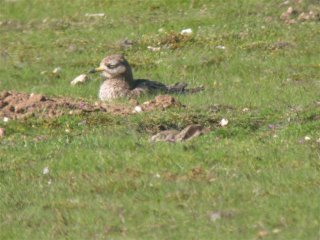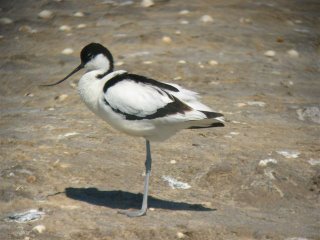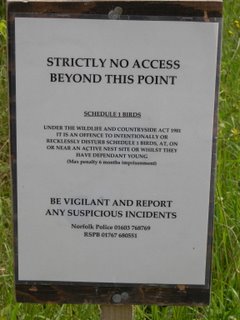
We arrived at Lakenheath (Hockwold Washes) at around 3:45am having left Cardiff at 11:45pm. Amazingly, we were not the first in the car park, as another car with three sleepers had already taken its place.
We got out at around 4:15am as the sun broke. First bird of the trip was a graceful
barn owl patrolling the reed beds.
Sedge warblers were waking up all over the place as we headed off for the poplar plantations. Before long we heard the strange “weeaa-weeoo” call of a male
golden oriole. We waited and waited, but this bird was not giving itself up easily – in fact not at all.
A couple of
cuckoos started calling and one came in to view, seemingly where the
golden oriole was calling from. We moved on to the second plantation as a number of other birders began to appear. A drake
garganey was out on the marsh between the two poplar plantations. We walked along the bank to the top of the plantation. A male was calling quite close, but not a glimpse did we see. A
green woodpecker and some
wood pigeons gave false alarms during a very frustrating watch. A couple of
common terns patrolled up and down the river to relieve the frustration.
We set off back to the first plantation and noticed a large crowd gathering there. One of the sleepers reported he’d seen a male flying from the second to first plantation. We were gutted. Sure enough, once we got to the crowd, they reported that the second male had been showing a few minutes earlier. We waited, but eventually decided to move on at around 8:15am in the hope of better luck elsewhere.

On to Weeting Heath, and the birding could not have been easier. We looked out of the hide window, and there were the
stone curlews no more than 40m away, with one on the nest and another just wandering about slowly. A few moments later a pair of
wood larks appeared, feeding right in front of the hide, and then a
stoat chasing
rabbits across the field. A
spotted flycatcher put in an appearance too.
With our spirits raised, we returned to Lakenheath for another pop at the
golden orioles. Again the bird in the first plantation was calling intermittently, but would not give himself up. We waited for another hour or so, but it seemed hopeless. We moved on.
BirdGuides was not giving much news of anything of real note, so we set off for Minsmere. It does not look too far on a map, but it took two hours to get there. On the way, we caught site of a large raptor over some trees. It was a
harrier, and almost certainly a
Montague’s, given its long, slender wings.

Minsmere is a fabulous reserve and the couple of hours we spent there didn’t do it justice. We saw a
hobby as we walked out to the east hide. Plenty of
terns were present, mostly
little and
common. On closer inspection, Dan picked out an
Artic tern. Another tern with a dark bill was of interest, especially as a
roseate tern had been on site for a few days. We attempted to make mental notes, but then a call came out that the
roseate tern was off to our right. We couldn’t get on it and it had clearly just passed over and back out to sea.
Nearby was a party of
little gulls, and the odd
redshank and
ringed plover were present along with a host of
avocets. Unfortunately, there was no sign of the
spotted sandpiper from the day before.
We returned to the reserve centre by walking along the sea path and were rewarded with a
bittern flying close-in. A short tea-break at the centre saw another flyover
bittern.
With no news of any
bee-eaters and a
red-backed shrike gone missing, we decided to head for Horsey in the slim hope of getting a
crane or two on the drive-by. It was quiet there too, so we pressed on and arrived at the King’s Arms around 7:30pm in time for a meal and a couple of pints.

Having enjoyed a good night’s sleep and waking to
house sparrows we popped to Cley Marshes before breakfast. The first bird again was a
barn owl hunting of the reeds before crossing the road. Soon there were five
marsh harriers in the air at once, including males and females. We walked out to the three hides in the middle of the marsh, in the hope of picking up some news of a decent bird or two, but it was very quiet. A
redshank perched on a post just a few feet outside the hide and Jeff rattled off a few snaps.
We returned to the King’s Arms for breakfast and were on the road again by 9:30am with one of our main target birds in mind. Along the coast road we ticked a
turtle dove sitting on some wires alongside the road.
The
Montague’s harrier site was easy to find, with a small crowd of birders set up just off the roadside. I met an old workmate and we learned that a watch point had been set up not too far away. We relocated and discovered that the birds were actually nesting in the rape field here. We were greeted by three old dears with:
“We are women …. we’ve seen it….”
Sure enough, the male had been on site no more than ten minutes prior to us arriving. When asked about the birds’ behaviour and the likely return time of the male for a possible food pass, the warden managing the site uttered the now unforgettable words:
“If you’re patient, you’ll see them”.
So we waited. ….. and we waited ….. and we waited. We were patient. Birders came and went, but we waited. We were men!

A
red kite, three
buzzards and a
hobby chasing hirundines added interest. A
grey partridge was added to Dan’s yearlist and another
turtle dove flew through. A
yellowhammer,
linnet and some
whitethroats kept us company and a male
marsh harrier patrolled the site all the time we were there.
It rained. We waited. We were men! More birders came and went, but we waited! The warden said:
“If you’d planned a weekend in Norfolk not to see
Montague’s harrier, this would be it”.
He couldn’t crack us though. We waited!
Obviously, after the burst of courtship activity in the first weeks after arriving, the female is on eggs and the male buggers off somewhere. Save the odd food pass in the morning there is actually not much to see. It is best to wait until the end of June and through July to see the birds. (We’ll do that next year!).
Sometime that day, with only a few more birders on site, a chap shouted:
“The female is up!”
The heart raced. Sure enough, we soon picked up the female gliding over the rape field, round and round and then she perched on a hedge. Clearly, she was wet and had decided to dry off and stretch her wings now that the rain had stopped and the sun was out once more. We all enjoyed great ‘scope views for a couple of minutes before she settled back to the nest.

Relief! We’d all definitely seen
Montague’s harrier in the UK. It was a corker too, and those wings – long, slender and almost pointed. Now for that male. We continued to wait in the hope of getting a food pass. A couple of false alarms as the male
marsh harrier appeared from time to time, and then out of the blue, the female was up again attacking the
marsh harrier. She really went at it. Talon grappling, chasing and she then they were on the ground together out of site, before they were up again and the
marsh harrier was chasing her. We watched for a few more minutes before she finally settled on the nest. Great stuff.
All the while a male
blackbird had been following proceedings for as long as us. Clearly another
harrier fan, waiting to see Lord Montague make an appearance.
We continued to wait and enjoyed another spat between
harrier species but we finally had to concede defeat in our quest to see a male
Montague’s harrier. We’d been patient …. we'd waited …. and waited …. we were men …. we were heroes …. we were knackered!
The full Monty? Perhaps not, but we’d certainly put the effort in and had been rewarded with some fantastic views of the female in action. The warden reported that on that day, 50 birders had visited, but only 11 had seen a
Montague’s harrier. We were part of that select few.
We set off home and had a relatively incident free journey, resolving never to go to Lakenheath again for invisible
golden orioles, and to try for
Montague’s harrier at the end of June or July next time.
Another great trip, and handful of year ticks and a couple of lifers taking me to 200 for the year.



 Friday was very warm and sunny, so after an early breakfast, we headed down to Minsmere. From the North Hide, many Avocets were obvious, and a smaller almost black wader was amongst them, a stunning summer plumage Spotted Redshank. Marsh Harriers were in view for much of the time, and Hobbies were seen. Walking from there to the beach, a Bittern flew low over us from the Dunwich direction. Many Sedge Warblers competed for our attention.
On the beach, some nesting Little Terns showed well, a distant dark phase Arctic Skua flew north, and from the East Hide 3 Med Gulls, including 2 adults were visible. A Spoonbill dropped in near North Hide, and another Bittern flew over the scrape.
We walked past the sluice, where 4 newly fledged Swallows were still being fed, and on to the South Hide. Common, Sandwich and Little Terns were all present, as were 3 summer plumaged Knot.
From the West Hide many Avocets showed well, but no chicks were visible.
After a quick snack back at the Visitor Centre, we made our way to the Bittern Hide, where a Marsh Harrier showed well in a nearby tree, and at least 2 more Hobbies were hunting.
From Island Mere Hide, many glimpses of Bearded Tits were had, mainly in flight low over the reeds. Just before we left, 2 1st s
Friday was very warm and sunny, so after an early breakfast, we headed down to Minsmere. From the North Hide, many Avocets were obvious, and a smaller almost black wader was amongst them, a stunning summer plumage Spotted Redshank. Marsh Harriers were in view for much of the time, and Hobbies were seen. Walking from there to the beach, a Bittern flew low over us from the Dunwich direction. Many Sedge Warblers competed for our attention.
On the beach, some nesting Little Terns showed well, a distant dark phase Arctic Skua flew north, and from the East Hide 3 Med Gulls, including 2 adults were visible. A Spoonbill dropped in near North Hide, and another Bittern flew over the scrape.
We walked past the sluice, where 4 newly fledged Swallows were still being fed, and on to the South Hide. Common, Sandwich and Little Terns were all present, as were 3 summer plumaged Knot.
From the West Hide many Avocets showed well, but no chicks were visible.
After a quick snack back at the Visitor Centre, we made our way to the Bittern Hide, where a Marsh Harrier showed well in a nearby tree, and at least 2 more Hobbies were hunting.
From Island Mere Hide, many glimpses of Bearded Tits were had, mainly in flight low over the reeds. Just before we left, 2 1st s ummer Little Gulls appeared over the water.
ummer Little Gulls appeared over the water.









